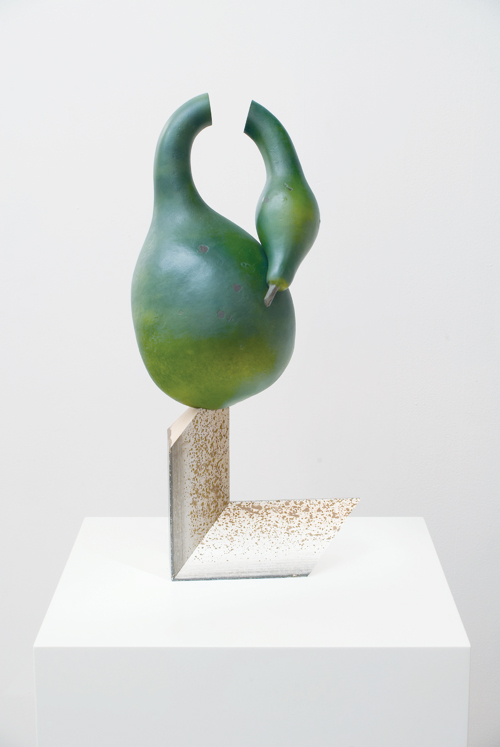Objects Food Rooms
Tanya Bonakdar, New York, USA
Tanya Bonakdar, New York, USA

‘Objects Food Rooms’ was an eclectic group show featuring 12 artists, inspired by Gertrude Stein’s 1914 book Tender Buttons. Stein’s text is, to put it charitably, difficult, and the show curated in its name by Andria Hickey was no less challenging.
Tender Buttons is divided into the three sections from which the exhibition took its title. In the first two, ‘Objects’ and ‘Food’, Stein treats the reader to a series of thematically appropriate headings such as ‘A Petticoat’ and ‘Eggs’, followed by passages ranging from inscrutable to ungrammatical. After ‘A Pastry’, for instance, comes this bafflement: ‘cutting shade, cool spades and little last beds, make violet, violet when’. The book gains momentum in the ‘Rooms’ section, where it progresses from lists to more expansive blocks of prose.
Stein favours objects that evoke people, many of which are fitted to the contours of particular bodies, such as ‘A Long Dress’ or ‘A Red Hat’. The exhibition took this anthropomorphizing project further, blurring bodies and their possessions. Ursula Mayer’s work, in particular, pits human forms against conspicuously inhuman content. Her sculpture Drawing Android 6 (2014) opposes the fragility of hair with the brutality of cables. From a rectangular concrete cast droop strands of hirsute black wire, the rigidity of its materials contrasting with the suppleness of real human bodies. Mayer is up to something similar in her phallic glass sculptures, See you in the Flesh 1–4 (2014), which wed a delicate medium with a primal form.
In a series of nine photographs, Voyage of the Beagle (2007), Rachel Harrison makes a similar move, personifying objects and objectifying persons: the photographs depict humanoid sculptures and mannequins alongside taxidermied animals and lumps of stone that suggest the traces of human faces. Like Mayer, Harrison animates objects, endowing them with traits typically reserved for living bodies. Conversely, she imposes a disconcerting stillness onto objects with human forms, prompting us to wonder whether memorialization amounts, inevitably, to entombment.
Stein is similarly skeptical of the apparatuses of signification: in Tender Buttons, she relates words not to the world but to one another. Aesthetics come apart from meaning in passages that privilege rhyming and alliteration over denotation (‘a little monkey goes like a donkey’). Language, which often serves to explain the world, works in Tender Buttons only to mystify it. The text, which evokes a muted, petit bourgeois interior (‘Piano’, ‘Mildred’s Umbrella’, ‘Cocoa and Clear Soup and Oranges and Oat-Meal’), renders a comfortable and essentially domestic space newly foreign.
Following Stein, Roula Partheniou’s installation, Packed Boxes with Clutter (2015), evokes dreams of domestic comfort that it then proceeds to dismantle. The painted wooden sculpture is designed to resemble a table laden with board games, a clock and a jumble of pots and pans. The result is uncannily like a real table, and its pretence of casual disorganization belies Partheniou’s careful deception.
In Laure Prouvost’s installation, The e-cigarette and the butter (2014), we are treated to an inversion of Partheniou’s work, intensifying the theatricality of a pair of banal household objects. In a darkened room, an e-cigarette and an unwrapped, sweaty slab of butter are mounted on the wall. Spotlights highlight first one, then the other. Viewers of the piece became newly sensitized to their surroundings, newly uncomfortable.























